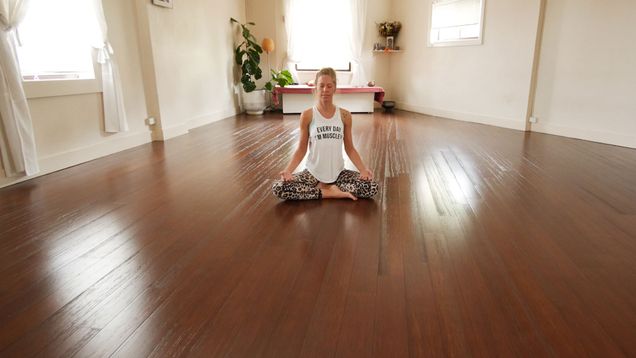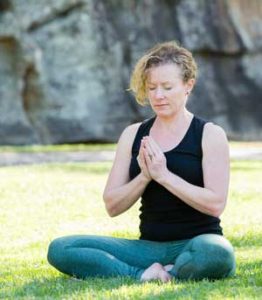by Michael de Manincor
 Yoga Psychology is an interesting term, perhaps a tautology, or at least it proposes an intriguing way of understanding psychology and the nature of the human condition, from an ancient wisdom culture.
Yoga Psychology is an interesting term, perhaps a tautology, or at least it proposes an intriguing way of understanding psychology and the nature of the human condition, from an ancient wisdom culture.
Yoga is all about the mind
The system of Yoga, developed and taught by Patanjali (a great Indian sage from over 2000 years ago), is defined as the development and refinement of the mind – what it is; how it works; known limitations and dysfunctional tendencies; what one can do to improve its levels of functioning; and with understanding and regular practice of the various components and techniques offered, what the mind might be capable of.
Yoga includes a complete understanding of mind in the context of a physical, breathing, social being, with implications for behaviour change, personal transformation and a flourishing life. Yoga is a holistic multi-dimensional system of health and well-being that focuses on the mind and its functions, with multi-component mind-body practices, including physical postures and movement, breathing exercises, deep relaxation, and mindfulness and meditation. Other aspects of yoga practice include cultivation of positive values, thoughts and attitudes, and lifestyle factors.
Modern misunderstanding of Yoga’s original focus and purpose
However, “yoga” in today’s world is no longer a term primarily associated with this ancient psychological system presented in Patanjali’s Yoga Sutras. Modern yoga is a much broader term that includes a growing number of popular styles and approaches, mostly associated with physical postures and group classes (gentle or intense, calming or energising, whatever style you like!), instructed by many people with limited education and training. Whilst these seem to provide considerable benefit and rewards for millions of people throughout the world, the system of Yoga is much more about a personal experience of the subtle mind-body-breath connection, than it is about physical strength or flexibility. In fact, these particular physical factors are somewhat (but not completely) irrelevant.
The importance of psychology in the context of overall health
The World Health Organisation (WHO) defines health as “a state of complete physical, mental and social well-being, and not merely the absence of disease or infirmity” (WHO Constitution, 1946). Mental health is defined as “a state of well-being in which every individual realises his or her own potential, can cope with the normal stresses of life, can work productively and fruitfully, and is able to make a contribution to her or his community” (weblink). Whilst “mental disorders”, including depression and anxiety, are also described and categorised using an extensive range of diagnostic labels, they are generally characterised by some combination of abnormal thoughts, emotions, behaviour, and relationships with others (weblink). And whilst mental health care is generally associated with the treatment of diagnosed disorders, WHO emphasises that “mental health is recognised as more than the absence of mental disorders. Mental health is an integral part of health. Indeed, there is no health without mental health” (weblink). These definitions eloquently describe in modern language, the essence of what Patanjali described in the system of Yoga, some 2000 years ago.
Mental health benefits of yoga
Yoga (or Yoga Psychology) includes approaches for the reduction or treatment of mental health concerns such as depression and anxiety, by utilising mind-body-lifestyle interventions, as well as cultivating a healthy (in the WHO sense of the word), productive and flourishing life (remember, there is more to Yoga than physical postures and group classes!).
It is well known that many people begin yoga for physical benefits, but over time, continue to practice yoga primarily for mental health benefits. A growing body of scientific evidence now supports the numerous personal and anecdotal claims of these mental health benefits, especially in the reduction of depression and anxiety. Again, caution is needed regarding what is actually meant by the “yoga” being studied. Broad sweeping claims about yoga and its benefits are not warranted. It is necessary to consider what particular components, approaches or techniques might have mental health benefits?
Research into the link between yoga practice and mental health
Reviews of the research suggest that caution is required in interpreting the results. Numerous limitations are identified in study design and methodology. The wide range of approaches and techniques used in different studies make it almost impossible to draw general conclusions about the benefits of yoga. And, rationale and details of the types of yoga included in the studies are often lacking. However, the research is promising in establishing an evidence-based approach of the mental health benefits of yoga.
As part of this ongoing research, we recently conducted two studies through the National Institute of Complementary Medicine (NICM), which is part of the School of Science and Health at the University of Western Sydney.
The first study sought to gain a consensus statement from experienced yoga teachers and researchers in the field of yoga and mental health throughout the world, on recommended approaches and techniques to include or avoid in yoga practices for people with depression or anxiety. The results of the study were used to develop “yoga for mental health intervention guidelines”, which have been presented at international Yoga Therapy and Positive Psychology conferences and published in the BMC Complementary and Alternative Medicine Journal.
The second study was a randomised clinical trial to evaluate the benefits of individualised yoga in addition to conventional or usual mental health care, for reducing depression and anxiety, and improve well-being. The study included over 100 participants. Each participant attended 4 private yoga sessions and was taught an individualised yoga practice to do at home over a period of 6 weeks. A range of measures for depression, anxiety, stress, psychological distress, general mental and physical health, well-being and resilience were included. Results suggest significant mental health benefits from individualised yoga plus usual care, compared to usual care alone.
Michael de Manincor is the Founder and Course Director at The Yoga Institute in Sydney. Michael is a Counselling Psychologist, Senior Yoga Teacher Trainer, Yoga Therapist, Former President and Honorary Life Member of Yoga Australia, founder of the charitable organisation The Yoga Foundation, and holds a PhD in Yoga and Mental Health.
How Can We Help You On Your Yoga Journey?
Our study options aren’t just for aspiring teachers, but for anyone who wants to deepen their personal practice or simply gain a better understanding of the breadth and depth of the life-affirming practice of yoga.
Interested in our 500-Hour Teacher Training Course?
Get course prospectus
Join our next information session
Prefer to start with a smaller commitment?
Learn more about our 100-Hour Yoga Studies course
Get in touch:
Email: teachertraining@yogainstitute.com.au
Phone: 0477 021 219
Join us, together we will grow, learn and inspire.





 by
by 
 Yoga Psychology is an interesting term, perhaps a tautology, or at least it proposes an intriguing way of understanding psychology and the nature of the human condition, from an ancient wisdom culture.
Yoga Psychology is an interesting term, perhaps a tautology, or at least it proposes an intriguing way of understanding psychology and the nature of the human condition, from an ancient wisdom culture.

 The fields of yoga, mindfulness and psychology converge in that they all encourage the practice of positive intentional activities to improve one’s emotional health and wellbeing. Why is it so important that we spend time practicing mindfulness and cultivating attitudes like gratitude?
The fields of yoga, mindfulness and psychology converge in that they all encourage the practice of positive intentional activities to improve one’s emotional health and wellbeing. Why is it so important that we spend time practicing mindfulness and cultivating attitudes like gratitude?